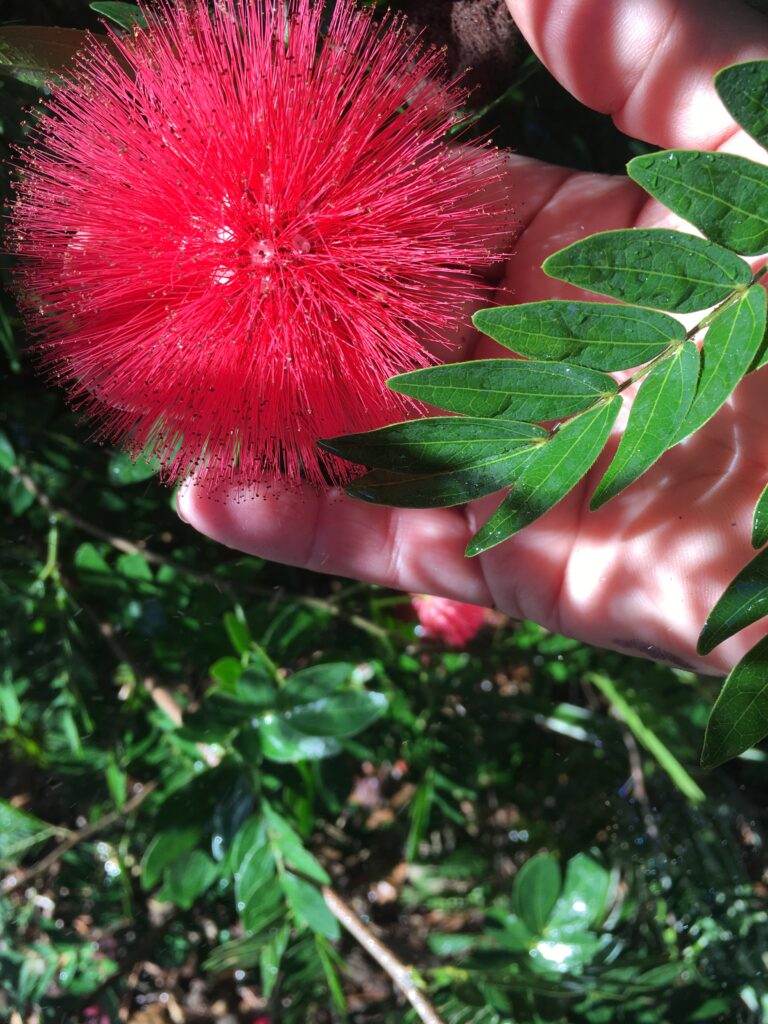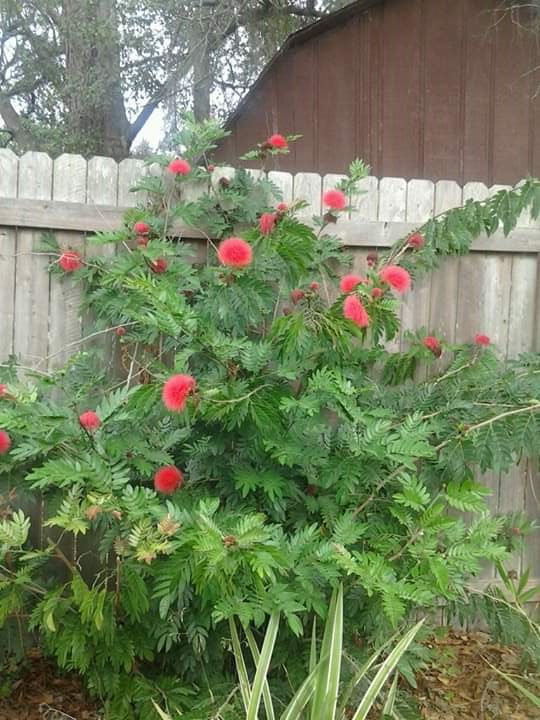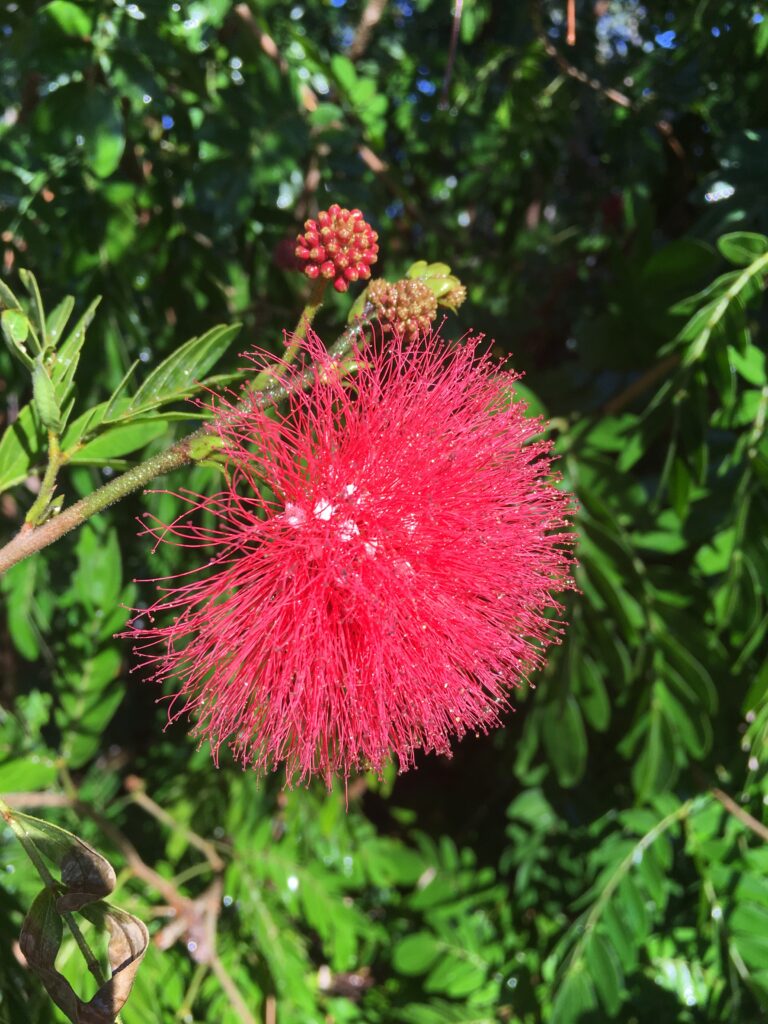S & J Tree Farm and Nursery’s Guide to Growing
Red Powder Puff Plants
in the Northeast Florida Landscape
Calliandra haematocephala
Pronunciation: kal-ee-AN-druh hee-mat-oh-SEFF-uh-luh
Red powder Puff / Calliandra haematocephala Origins:

– Native to Bolivia, these beautiful flowering plants used to be categorized in the legume family and have been reclassified with mimosas. Unlike the Invasive Mimosa trees, Calliandras have been evaluated by UFIFAS and not found to be of any threat to our natural environment and make a great substitute for the Mimosa tree we all fell in love with growing up in the south. While those have taken over these have remained contained to the gardens in which they are planted and can be utilized in our landcapes without concern. Calliandra haematocephala is cold hardy to 20-25 degrees. They can be planted in zones 9-11, but you can expect some damage to stems, foliage and flowers when temperatures are in the low 30s and branch damage happens a little under that, so cover them or let them go and trim off damaged stems for quick recovery in the spring when all danger of frost has passed. I have grown these plants for over 20 years and have had one in my St. Johns home landscape for near 15 years that has yet to receive more damage than some leaves and stems that it recovered from quickly but I did take care to plant them into frost free areas of landscapes. Plants damaged to ground level during harsh winters here in North Florida will regrow new trunks the following summer, much like Cassia trees, or hibiscus plants if you are familiar with those. Expect to see something happening by May, and good recovery speed during the heat of the summer for trees to be back up by bloom time in the fall.
– Although these plants are hard to come by, they are worth the wait if your having difficulty locating them to add them to your landscape. I stock them every time I can find them here at S & J Nursery! Cultivated for their soft pink blooms and easy maintenance plant habit. Red cestrum blooms sporadically in late spring, summer and fall.
Sun Exposure for the Red powder Puff / Calliandra haematocephala :
– best planted in areas that will receive full or partial sun. In Northeast Florida, a plant receiving 6 hours or more of sun exposure is considered to be planted in a full sun location. Morning shade and afternoon sun is ideal, or filtered light under taller growing shade trees where grass is receiving enough light to flourish. Plants will bloom less in lower light areas but may be better protected from damaging winter frosts in those same partially locations.
– Protect from frost, utilize your gardens microclimates. Best if planted on the south side of the house away from cold north winds, up next to a fence or near the foundation of a home or other building, plant on the west side of a home or building, or near larger shade trees that will protect these tropical plants from frost. Or plant on the west side of a home or building.
Foliage of the Red powder Puff / Calliandra haematocephala:
– Medium semi evergreen foliage depending on winter temperatures) in zone 9-11. Foliage may remain evergreen or may drop in our Northeast Florida area gardens. leaves and stems will quickly regrow the following summer in the Jacksonville and St. Augustine area gardens.
Soil Preference / Salt tolerance of the Red Powder Puff / Calliandra haematocephala:
– Powder Puff plants are at home in our Northeast Florida’s sandy soils and are fairly drought tolerant once established but will also thrive in moist soil locations. Amend the soil when planting with compost to help your Jacksonville and St. Augustine area soil hold both water and nutrients and keep your Powder Puff plants healthy and blooming.
– Salt tolerance unknown. Have you tried it? Tell us how it went!
Size Variance of Red Powder Puff / Calliandra haematocephala:
– Plants can reach heights of 10-15 ft in height and 8-10 ft in width . Fast growing and difficult to keep pruned lower or into espalier shaped as plants quickly shoot out new growth when trimmed. These, in my opinion are best used as accent plants or small trees and don’t make a suitable hedge unless you have plenty of room for them widthwise and want a sizable hedge screen, then they may just be perfect!
Growth Habit of the Size Variance of Red Powder Puff / Calliandra haematocephala Plants:

– Upright, sprawling foliage will tend to arch downwards especially when in bloom giving the plant an overall semi weeping arhced habit. .
– Responds well to pruning, so don’t be afraid to cut them back and keep them nice and tidy!
Growth Rate of the Size Variance of Red Powder Puff / Calliandra haematocephala Plant:
– Fast growing particularly during the hot summer months!
Blooms of the Red Powder Puff / Calliandra haematocephala:
– Gorgeous cylindrical blooms in fall and winter time and sometimes blooming right into spring.
– pollinator attracting blooms.
Water Requirements of the Red Powder Puff / Calliandra haematocephala:
– Although much more durable once established in the landscape, regular water is necessary to get the plant rooted and growing on its own after being planted in the ground from an S & J Nursery container.
Watering New larger Shrubs and Trees
Best Uses For Red Powder Puff in the Jacksonville | St. Augustine Area
Landscapes :
– Powder Puffs are an excellent small scale accent tree for the landscape and have a stunning flower display!
– Pollinator attracting
Care of Red Powder Puff in the Northeast Florida Landscape:

– Amend sandy soils generously with compost to help your newly planted Powder Puffs get the much needed water and nutrients it takes to feed these heavy blooming beauties.
– Water every day during the establishment period after planting in the garden from an S & J Nursery container. Be sure to continue supplemental irrigation during the hot summer months during prolonged drought.
– Fertilize each year just after trimming in the spring with a good shovel full
of garden compost or use Osmocote or another slow release plant food spring, summer and fall.
– When temperatures drop into the 25-30 degrees you may opt to protect your foliage and stems from severe frost damage by throwing a blanket or other breathable fabric over the top of the plant making sure the edges touch the ground to trap in the heat from the soil.
– Make your last summer pruning in August giving your Powder puff plant ample time to recover new foliage that will harden off before winter arrives for us here in late December. Pruning too late into the fall will cause flushes of cold sensitive new growth that is sure to freeze during even a light frost that hardened off foliage would not be affected by.
– DO NOT REMOVE WINTER BURNT FOLIAGE UNTIL ALL DANGER OF FROST HAS PASSED. Be sure not to remove any stems or leaves from the plant until we have reached the last average frost date and there are no late freezes being predicted. (mid February for Northeast Florida is the average last frost date) Trimming burnt foliage and stems before then will leave bare branches deeper on the plant exposed to cold temperatures that would have been protected by those same stems and foliage if left unpruned and most often results in loss of the plant entirely.

